Introduction to Modern Small Business Websites
Why Your Small Business Needs a Website
Small Business Website Building Blocks
Top Small Business Website Building Platforms
Budgeting for Your Small Business Website
Building a Small Business Website
Small Business Website Optimization
Promoting a Small Business Website
Mistakes to Avoid as a New Small Business Website Owner
Beyond Small Business Websites
Introduction to Modern Small Business Websites
As a small business owner, you are part of an extraordinary growing movement. According to the US Small Business Administration, small businesses account for 99.7% of all businesses in the United States. Small businesses also account for slightly over 50% of all jobs in the economy, and for 70% of all new jobs created each year. While these stats are impressive, small businesses also face numerous challenges on the path to success.
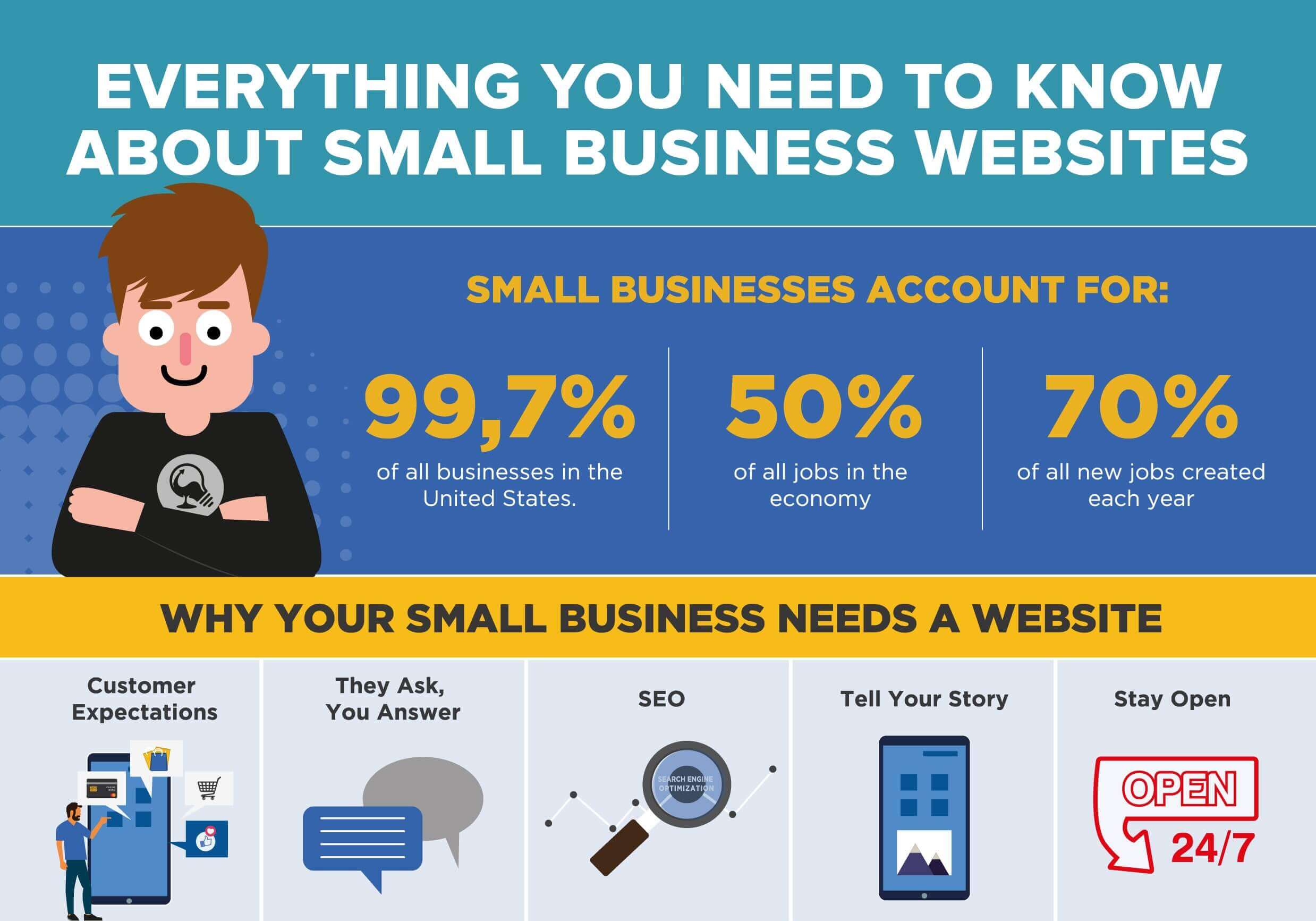
The US SBA (Small Business Administration) notes that up to 50% of all new businesses do not survive to their fifth year. Of those that make it to five years, only one third will make it to their tenth anniversary. However, the advent of the internet has given small businesses a valuable ace up their sleeves: small business websites.
For most small business owners, marketing is at the heart of their daily business activities. A LeadPages study found that 47% of small business owners handle marketing for their businesses alone. Add to this other tasks, such as sales, inventory management and customer relations – and what you get is a seriously overworked and inefficient entrepreneur.
With so much on a small business owner’s plate, turning to technology is the best way to increase productivity. Think of your website as an extra employee who works 24/7, handing marketing, answering customer questions, and even generating sales.
If websites play such a crucial role, why don’t more small businesses have them? The answer lies in the rapid rise of web technologies. What used to be a simple task of putting together an HTML website has turned into a long process of sifting through dozens of website options.
Add to this SEO, Google search algorithms and other web standards, and the average small business owner simply does not have the time or resources to keep up. Although many small businesses are aware of the fact that their business needs a website, the complex process of making a website often seems unclear, time-consuming and expensive.

This in-depth guide will demystify and simplify the small business website. With all the options out there, it can be challenging to find just the essential information you need to set up your small business website. This guide cuts out all the noise and offers you just what you need to know to make an informed decision about building a website.
Why Your Small Business Needs a Website
Every small business needs a website. Whether you run a carwash, a landscaping, or a dog walking business, having a website is crucial to the growth and success of your company. You may still be thinking: my business has been doing well so far without a website, if it isn’t broken, why fix it? To help you get a clearer picture of why your small business needs a website, here are the top five reasons you need one:
1. Customer Expectations
Regardless of the industry, the average customer has come to expect every business to offer them a complete digital experience. People are used to doing everything on their smartphones; from looking up the weather to paying bills and booking a flight. Without one, most potential clients will simply do business with the next competitor with a website.
2. They Ask, You Answer
Answering your customers’ questions is how you make a sale. In the past, customers walked into your store and asked questions. Today, they visit your website first. Having a website ensures that when they ask, you are there to answer. A website with all the answers to questions a typical customer would ask is a sure way to attract more leads, make more sales and get repeat business.
3. Search Engine Optimization (SEO)
Without a good SEO strategy in place, it would be difficult for people to find you online. Without a website, however, it would be impossible for anyone to find you online in the first place. The next step is to get your website on that all important first page of google search , because stats show that 75% of users never even open the second page of search results.
4. Tell Your Story
What’s the difference between someone else telling your story and telling the story yourself? Context. When you tell your story, you give it the right context and focus on the things that you find important and valuable. A good website gives you this luxury. By controlling the narrative on your website, you can mold and shape your brand and story to match your customers’ needs.
5. Stay Open 24/7/365
Availability is perhaps the most important value that a website brings to the table. It keeps you open for business around the clock, every day of the year. What’s more, it does this without any added expense to you. Make sure your business is responsive at all times. You cannot afford to close for the day while your competitors remain open.
Small Business Website Building Blocks
Three main building blocks go into creating a small business website: design, content, and code. Before we look at each of these in detail, it is important to note that each of these building blocks can have a myriad of possibilities and options. For a small business website, however, we suggest a simplified approach to each.
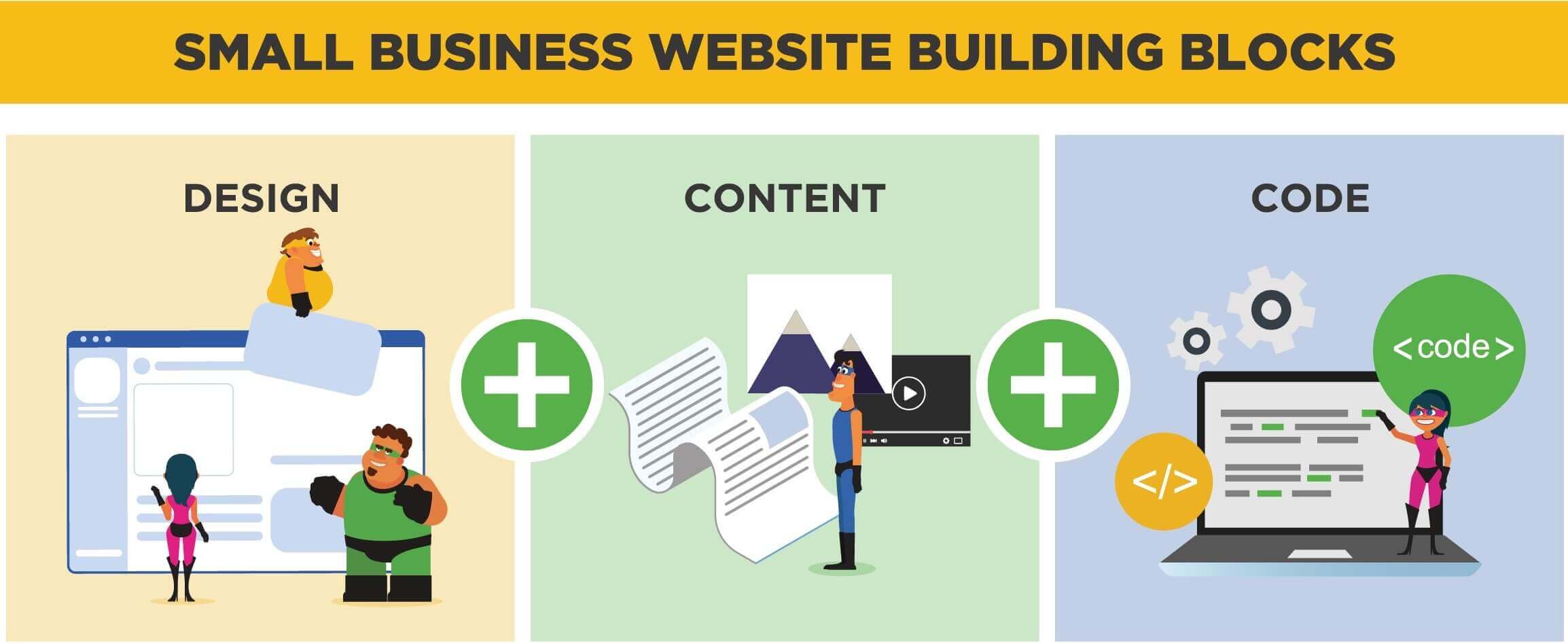
Design
Design is where it all begins. If you are thinking of getting a website, you doubtless have some color schemes in mind; possibly your logo colors. You probably have some ideas based on other websites you have seen, and so on. These details go into the design aspect of your website. Design is important because it is what people see and interact with when they come to your website.
When it comes to the overall website design, you need to think about user experience design (or UX in it slang) as well as user interface design (UI). UX dictates how people interact with your site, while UI deals with what people see as they interact with it.
Content
Content is the next important building block. Content can be text, images, videos, graphics, gifs, and almost anything else you can upload to your site. Content matters because it is how you tell your story and get your message across.
If you offer certain goods or services, content gives you a medium to market them in the best light. For an e-commerce website, you will need high-quality product images and descriptions; while for a services company, you will need high-quality content for your services, about us, team and contact pages.
Code
Code is the scaffolding that supports both design and content. When a user visits your website, their browser reads and interprets the code on your website to generate the visual experience. Quality code is essential for this experience to be efficient, as well as enjoyable for the user. Within the code, elements like structured data, responsiveness, and compression ensure the website is easily accessible to search engines and web browsers, and guarantees a fast and smooth experience for visitors.
When high-quality design, content, and code converge a website runs reliably, and meets the expectations of both the website owner and the visitors. Working with an experienced web development agency (like Bleeding Bulb) is crucial to achieving this, as they will have the experience and expertise to provide high-quality results.
Top Small-Business Website Building Platforms
There are tons of website building platforms on the market today, not to mention the hundreds of software frameworks available. Picking the right platform requires a careful balancing act between cost, functionality, and ease of use. In this list, we look at the pros and cons of the six most popular website building platforms.
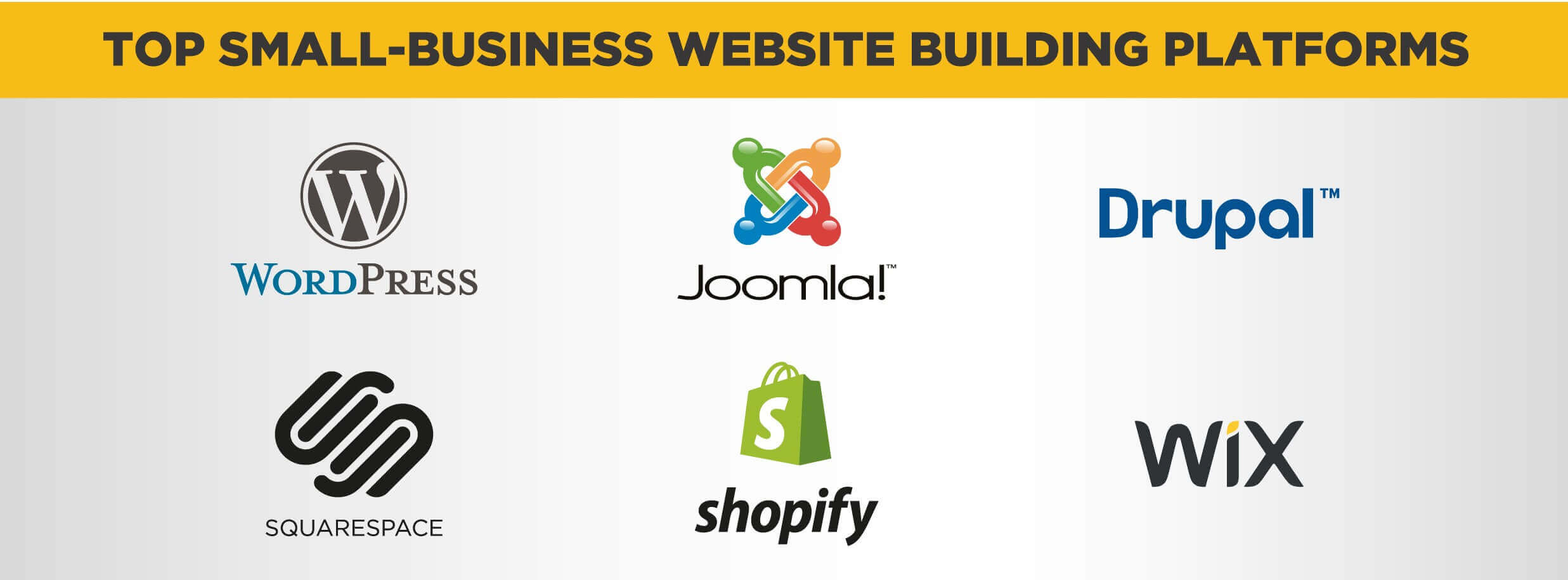

WordPress
Pros:
WordPress is the most popular website platform with 32% of all websites on the Internet built using it. It is user-friendly, has tons of plugins, promotes SEO through in-built features and plugins, and keeps up with web trends like mobile optimization.
Cons:
Has frequent updates that can be a challenge to manage, is open-source hence attractive to hackers, can be slow due to plugins and theme elements and requires advanced skills to customize.
Joomla
Pros:
The second most popular CMS by market share, Joomla is open source, has advanced e-commerce features, and offers content and structural flexibility.
Cons:
Is complex for first-time users, the module (plugin) marketplace is small, and requires significantly more server resources to run compared to other platforms in this list.
Drupal
Pros:
Third in popularity by market share, Drupal is open-source so does not have any licensing fees, is developer friendly, has advanced features to build complex websites and is extremely flexible and versatile.
Cons:
Requires advanced technical skills and is difficult to install and manage.
Squarespace
Pros:
Squarespace powers over a million websites and offers a myriad of templates and designs, has advanced e-commerce features, and excellent support.
Cons:
The biggest challenges with the platform include expensive pricing compared to other platforms, limited customization options, and poor SEO and page speed performance.
Shopify
Pros:
Shopify is the most popular e-commerce platform for good reason. Pros include multi-channel selling (mobile apps, web store, Facebook, Pinterest, Amazon, etc.,) support for almost every payment processor globally, great website performance, support for the sale of digital and non-digital goods, and integration with in-store POS.
Cons:
Customization requires advanced coding skills, advanced features come at a steep cost, and apps/ plugins come as a separate cost.
Wix
Pros:
Wix offers a free trial, has hundreds of free templates you can use, offers an easy drag-and-drop website editor and integrates with hundreds of third-party apps.
Cons:
Free trial comes with ads that display on your website, e-commerce features come at an added cost, offers limited customization options and results in relatively slow websites.
The type of business you run and the kind of website you want will determine which platform will work best for you. Other things to consider include budgeting and whether or not you have the technical skills and time to manage the website yourself. The best way to sort through all these factors is to work with an experienced web design agency that can offer you a comprehensive comparison of the various platforms based on your requirements.
For more info on blog platforms, check out our post about blogging.
Budgeting for Your Small-Business Website
How much does it cost to build a small business website? How much do a domain name and web hosting cost? Such questions are often on the minds of small business owners thinking of getting a website. The short answer is: it depends. Below we look at three areas that will affect the final cost and give you ball-park prices for each.

Domain, SSL Certificate, and Hosting
To have a website you need a domain name. Most .com domain names cost around $10 – $15 per year. Sometimes it is difficult to find a .com domain name for your business due to availability, so you may need to go for other extensions, like .us or .net.
You will also need an SSL certificate to ensure your website is secure and encrypted. These can go for anything from $0 (LetsEncrypt) to $1499 per year (VeriSign.) Hosting is the next cost you will incur, and this can range from as low as $8 per month (e.g., Bluehost) to $299 per month (e.g., Shopify.)
Design and Development
Once you have a domain name, SSL certificate and hosting, the next step is design and development. Design can be approached in several ways. Custom designs will set you back upwards of $1,500, while purchasing a ready-made theme will cost you around $100. Custom development will cost you an additional $2000 or more, depending on website complexity.
Although purchasing a theme may seem like the better choice, keep in mind that themes offer limited features, require professional installation, may need extensive customization and require securing before going live. All these additional services could run up the final cost, so you might well be better of building your website from scratch.
Content
A typical small business website has around 20 pages, each with text content, images, and graphics. You will need to work with a web design agency that offers these services. How much this will cost will depend on the number of pages your website has, the amount of content each page will require and the types of content.
Text is the cheapest, followed by graphical and image content, while video content is the most expensive to create. Expect to pay $25 – $100 an hour for copywriting, $50 – $150 an hour for graphic design and photography and $200 – $500 an hour for video shooting/editing.
Budgeting for your small business website requires first creating a scope of what you want and then discussing the costs with a reputable web development agency. Although many small businesses turn to freelancers to cut costs, finding quality, reliable freelancers can be difficult. Managing the work can be challenging and most freelancers will not offer any guarantees in case things do not work out. Working with an established web design and development agency is therefore recommended, especially for those setting up a website for the first time.
Building a Small-Business Website
Starting a website development project can be daunting. You know what you want but the steps to get it can seem unclear. In this section, we look at the actual steps to take when building a website. These steps cater to small businesses that want to work with someone to build the website for them.
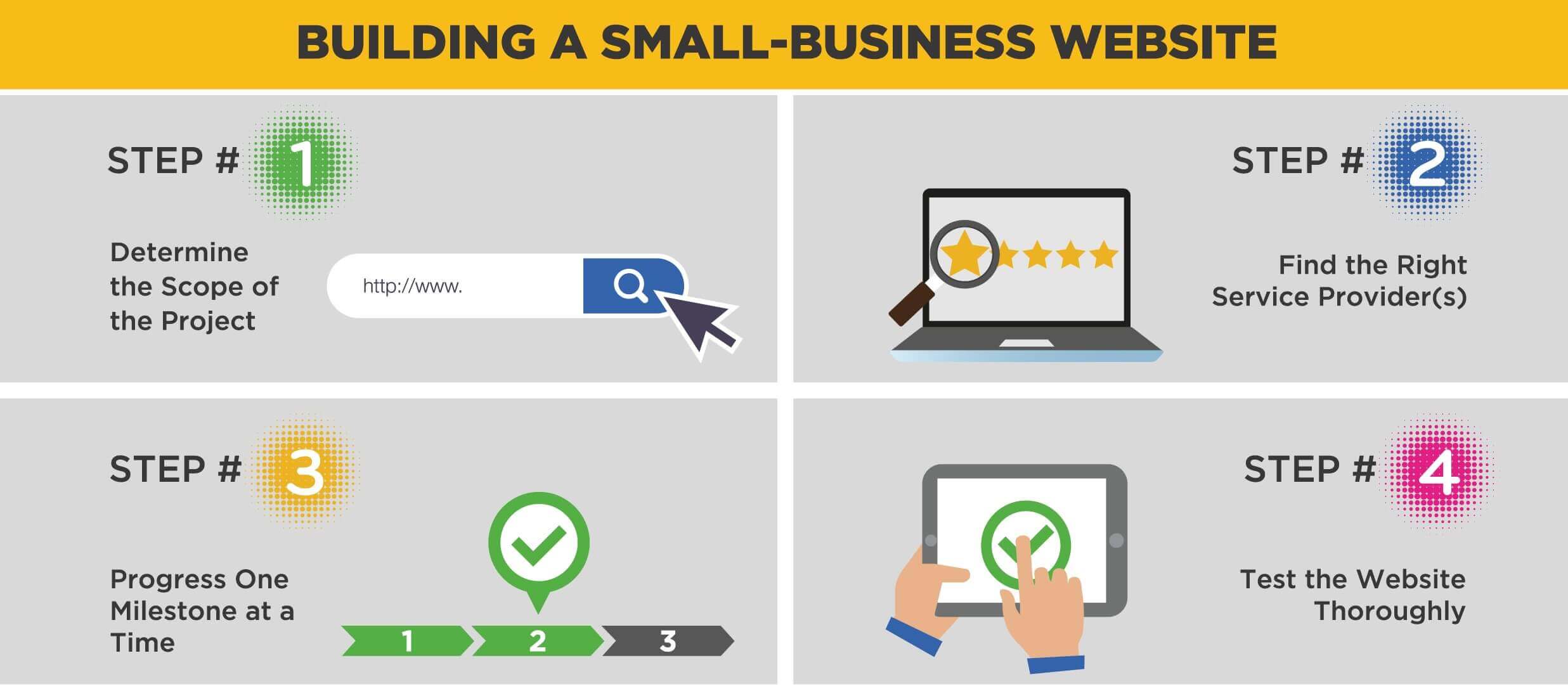
Step #1: Determine the Scope of the Project
To get some general ideas for what your website should look like, do a Google search for similar businesses to yours in your area. How big are their websites? How many pages do they have? Are they fast or slow? Save links to the websites you like. Next, write down what you want your website to accomplish. Will you be taking appointments through the website? Will it have a subscription box for a newsletter? The more thoroughly you define your scope, the easier the next step will be.
Step #2: Find the Right Service Provider(s)
The service providers you will need include a web design and a content development firm. Finding the right service providers is often the most challenging part of the entire project. Most service providers you approach will offer you the moon and stars, so it will be hard to take them on their word.
Instead, ask for a portfolio of their previous work. If available, pick a past project they did that is similar to yours and ask them to walk you through it. If possible, ask to speak with a few past clients as well. A reputable firm will have all these details available for you. After picking the best-fit service provider(s) for your needs, the next step will ensure they deliver what you want.
Step #3: Progress One Milestone at a Time
Milestones keep everyone on the same page. Make sure your website development project is broken down into manageable milestones. Have your team send you a mockup of (or content for) the homepage as the first milestone. If you like it, then you can proceed. If you don’t, you will only have to part with a small fee for that page. In general, go with between five and ten milestones to maintain control over the project but not to slow it down with too many.
Step #4: Test the Website Thoroughly
At the end of each milestone, test each page thoroughly. If you can, send the links to friends and family to test the website and offer feedback on the design, speed, content, etc. This stage is important because most issues are only spotted ‘in the wild,’ that is, in an uncontrolled, live environment. The other reason you want to test the website is to ensure you can access it easily and run simple maintenance tasks like updating content or publishing a blog post.
Once the website is complete, you should give yourself a big pat on the back because you have taken a significant step towards taking your business to the next level. Other important actions to take during this phase include discussing after-sales support, and pricing for any maintenance work you may need in the future. Once you are done with these steps, you will be ready to move to optimization.
Small-Business Website Optimization
Once your website is built and ready to go, it’s time to optimize. Depending on what platform you are using, the objectives below can be achieved either by installing plugins (WordPress) or through third-party apps (Shopify.)
Here are the top 6 optimization areas you need to focus on:
1. Search Engine Optimization
SEO is a major optimization area as it determines how “findable” your website is. To achieve great SEO results, you will need to research the top keywords in your niche and apply them to your website using high-quality content. You will also need to add metadata and structured data to your pages to make them stand out to search engines.
2. Mobile-readiness
Google is currently rolling out what it calls mobile-first indexing. What this means is that websites that are optimized for mobile viewing will be given priority over those that are only optimized for desktop viewing. To stay on the right side of these big changes, you will need to ensure your website is either responsive (changes to fit different device screens) or has a separate mobile website. You can test the mobile-readiness of any website using a variety of free online resources.
3. Security
Hackers and spammers target small business website primarily to hijack them and use them as link and spam farms. To avoid this, ensure your website not only has a valid SSL certificate, but also has other protections like Akismet (spam filter for WordPress), double validation (server and client sides) and a strong password (consider using a password manager like LastPass or Dashlane).
4. Continuity
Assuming the worst happens, and your website gets compromised, what do you do? If you didn’t have any backups, you’d be forced to start everything from scratch. To ensure the continuity of your website, you will need to optimize it with a backup tool. In WordPress, this would mean installing a backup plugin like VaultPress.
5. Connectedness
Visitors coming to your website may want to know if you are on Facebook or Twitter. They may also want to share some of your content to their social networks. Optimizing your website for social sharing is an important step, especially with so many people using social media. Add share buttons to some or all of your pages and add widgets that link to your social media profiles.
6. Performance
How fast is your website? How well does it render on different devices? Using performance testing tools like those found at web.dev can help you optimize your website to provide a modern, smooth and delightful experience to visitors.
Promoting a Small-Business Website
Building and optimizing a small business website is half the journey towards small business website success. The other half consists of ongoing efforts to promote your website. This is crucial because it’s through promotion activities that you will attract new leads, build an email list, establish your brand online and grow a community around your business.
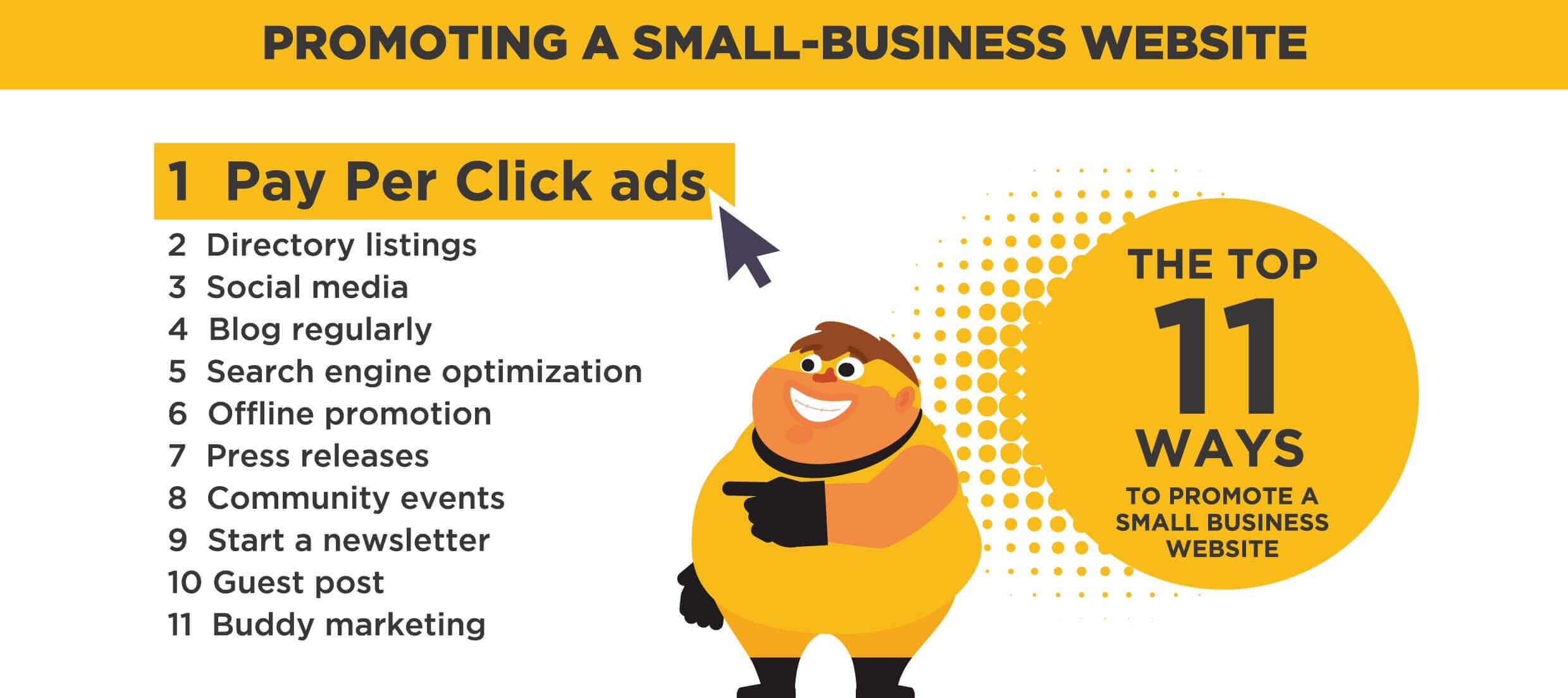
To get you started, here are the top 11 ways to promote a small business website:
1. Pay Per Click ads – PPC or online ads are a fast though costly way to get instant traffic to your website. If you can justify the cost of PPC, then it can provide a steady stream of traffic to your website.
2. Directory listings – List your website on the big three listing platforms: Google Places, Yahoo! Local and Bing. Go further and list your business and website on others like Yelp, Angie’s List, Better Business Bureau, and Merchant Circle.
3. Social media – Create social media profiles and list your website on them. Focus on two or three large social media websites to start with. We recommend Facebook, LinkedIn, and Twitter.
4. Blog regularly – Blogging about topics in your industry will notify search engines to start showing your posts for relevant searches. This will increase the exposure of your website. Remember to share your posts widely on social media too.
5. Search engine optimization – Creating content optimized for the keywords people are searching in your industry is another excellent way to get your website noticed.
6. Offline promotion – Add your website address to all your marketing and sales materials, and anywhere else people may see it, like storefronts, cars, work clothes, etc.
7. Press releases – If you don’t announce your new website, no one will know it exists. Create press releases and send them out to local news channels, journalists, bloggers, and anyone else you can think of.
8. Community events – Participate in community events and groups, both online and offline, and use them as networking opportunities to send people to your website.
9. Start a newsletter – Encourage people to register for your newsletter and send out interesting and exclusive content to them regularly.
10. Guest post – This means writing articles and requesting to be published on other websites with a byline that links back to yours. It will get you more exposure as well as an opportunity to attract new visitors to your website.
11. Buddy marketing – Approach other local businesses and cross-promote each other. This can be through backlinks or by sharing the costs of putting up a billboard or distributing marketing materials with your web addresses listed.
Promoting your small business website will be an ongoing journey that requires dedication, creativity and an investment of money and time. The benefit of sticking to it is that your website will grow in authority, brand value and search engine rankings as you keep promoting it. This can ultimately lead to a steady flow of business with little input from you.
Mistakes to Avoid as a New Small-Business Website Owner
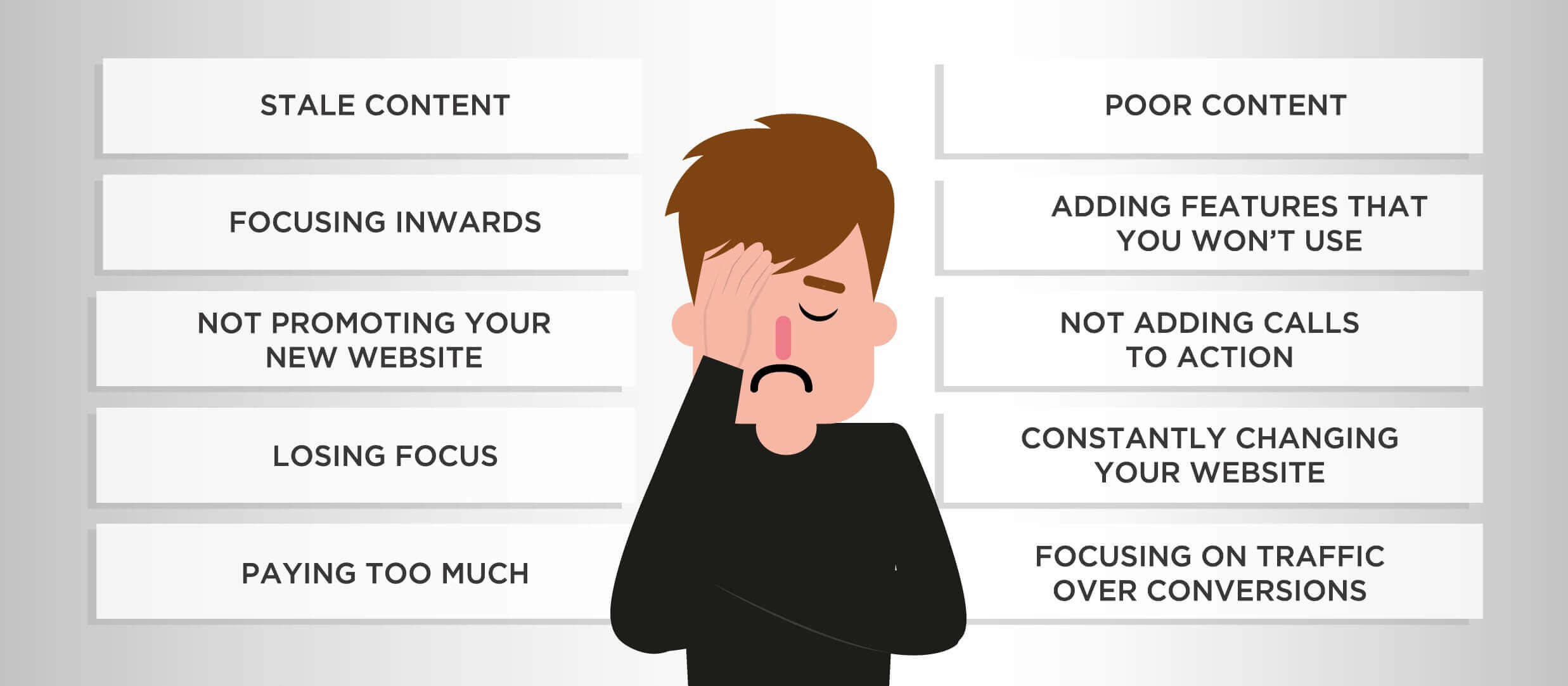
It is always good to learn from your mistakes, but it is a lot better to learn from the mistakes of others. To ensure your road to online success is a smooth one, here are ten common mistakes you should avoid as a new small business website owner:
1. Stale content – If you change anything business related, such as a phone number, address or price list, make sure to make the change on your website too.
2. Poor content – Poor content can be defined as poorly written, overly written, underwritten content. Poor content has bad images, and is hard or unpleasant to consume. Unless you have the skills, let a professional create the content for your site .
3. Focusing inwards – Using too many ‘I, we, our, my, mine,’ kind of words has been shown to put off readers. Go for statements that use ‘you, your,’ to put the focus on your website visitors.
4. Adding features that you won’t use – Don’t add a shopping cart, shop and entire e-commerce section if you do not have anything you can sell online. Removing unnecessary clutter on your website will result in a far more enjoyable user experience.
5. Not promoting your new website – If you don’t promote your new website, it will wither on the vine. To get the most out of your investment, ensure you have a solid promotion plan in place.
6. Not adding calls to action – Otherwise known as CTAs, these are statements that compel a person to take a specific and measurable action. For instance, ‘Subscribe to Our Newsletter.’
7. Losing focus – If you are creating content for your website and there’s no traffic, you may be tempted to publish cat memes or other non-relevant content. Resists the urge, it will only harm your website in the long run.
8. Constantly changing your website – No matter how much you want to change things up, try and maintain one design for at least two years. People get used to the look and feel of a website they use often, and frequent changes can put them off. When you do decide to change something, inform your visitors in advance, and provide information about what features have been changed, removed, or added.
9. Paying too much – Paying $20,000 for a simple small business website is simply not worth it. Be reasonable with your budget and expectations, once your business grows you can think about upgrading your website.
10. Focusing on traffic over conversions – It’s easy to obsess over the traffic to your site, and to do anything to increase it: but traffic for traffic’s sake is pointless. Focus instead on the tangible value your website is bringing your business; like leads, subscriptions and sales.
Beyond Small-Business Websites
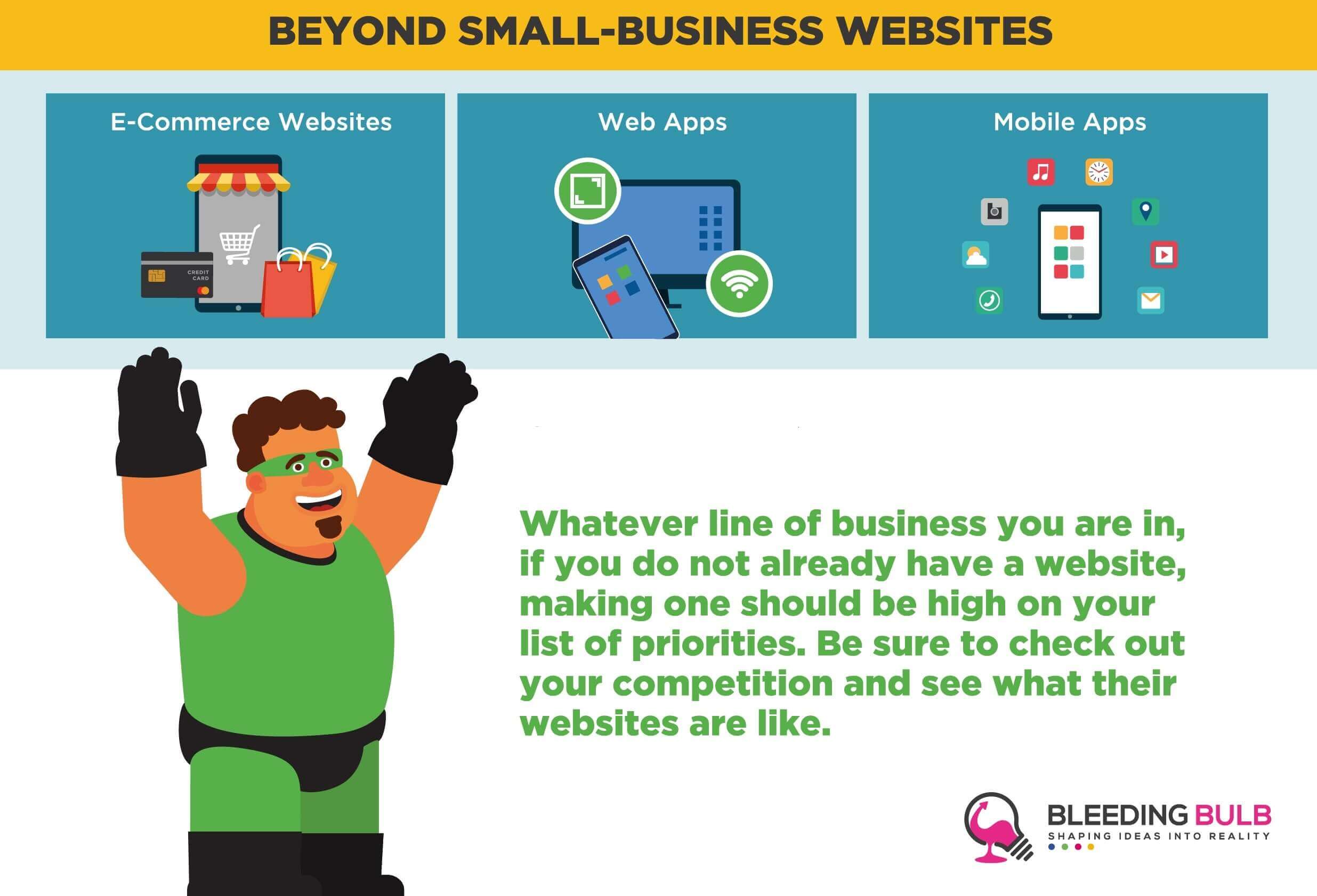
As your small business grows and your online needs evolve, you may find yourself needing more online functionality. This could be because you are expanding sales online or want to reach a new mass-market consumer segment for your products or services. When you reach this point, here are three main options you can look at:
E-Commerce Websites
E-commerce websites differ from typical websites because they are optimized to handle online transactions. If you want to sell physical or digital goods online, you will need additional features such as a payment gateway, a shopping cart, product listing section, shipping calculator, inventory management system and others. As such, building an e-commerce website is a radically different exercise from building an informational small business website.
Web Apps
Web apps are sophisticated applications that deliver software program features over the internet. Examples of web apps include Google Docs, QuickBooks, Netflix, Evernote, and others. As a small business, you may want to deliver certain services to your customers, such as a customer reward program or a customer service portal, both of which would require a web app.
Mobile Apps
Both Android and iOS mobile apps are extremely popular. They make it easy for customers to interact with a business and help it stand out from the competition. It is important to note that mobile apps are both expensive to build and maintain, and do not always add value to a business.
Conclusion
Whatever line of business you are in, if you do not already have a website, making one should be high on your list of priorities. Be sure to check out your competition and see what their websites are like. Just throwing money at your website is not enough for it to be successful, you will need to do your due diligence. More than likely, there will also be some trial and error.
Hopefully, we have given you the information you need for a solid understanding of how to go about creating a successful website for your small business. While this guide is by no means complete, we have attempted to cover all the important aspects of small business websites. Good luck on your website journey.


